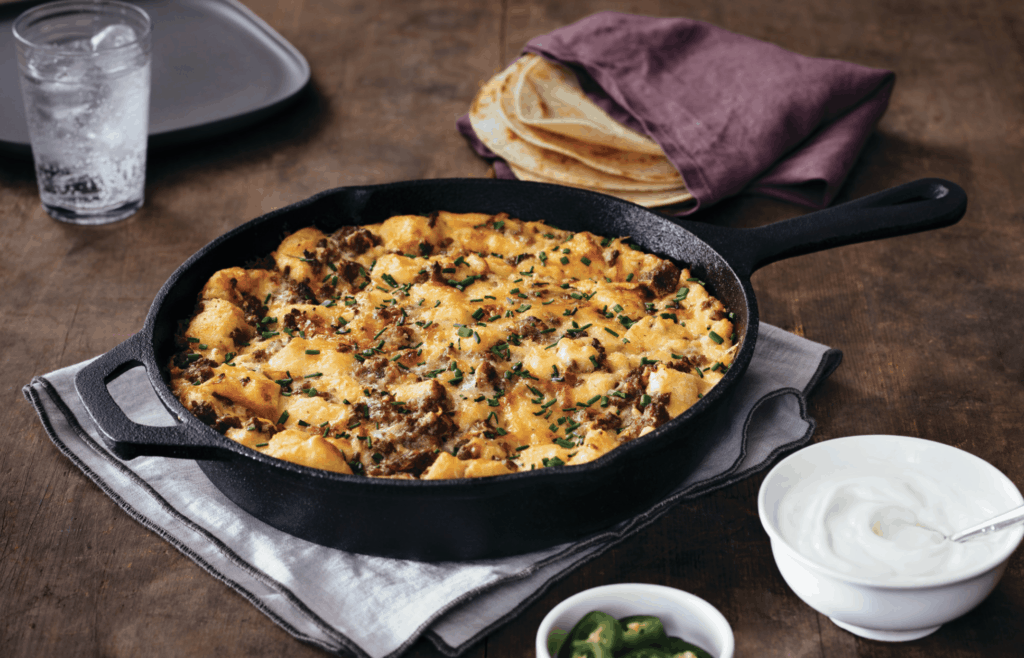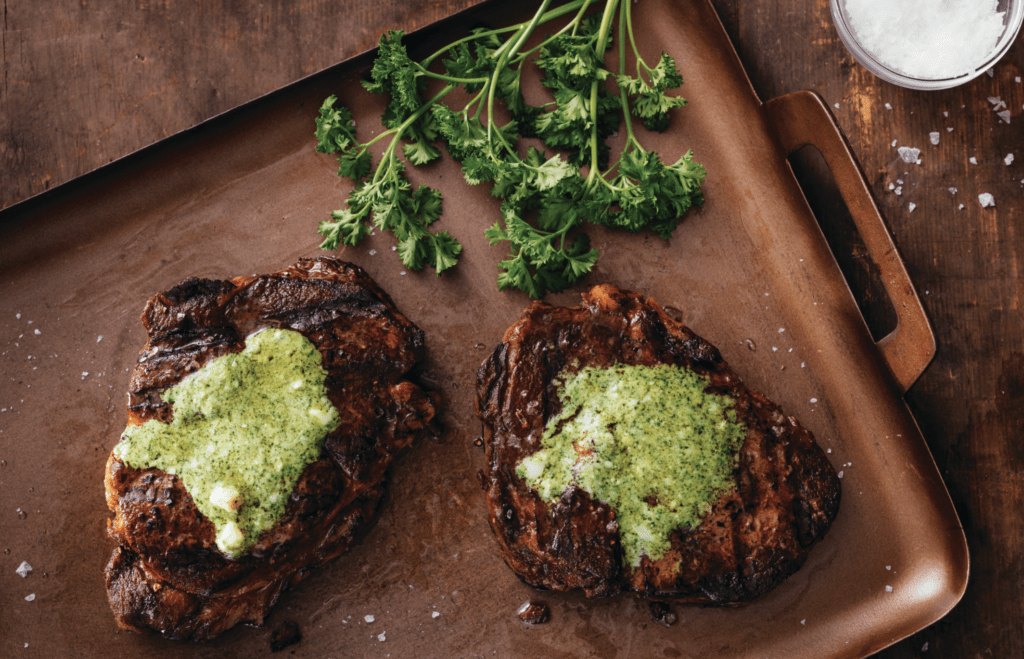
Photographed by Adam DeTour; Styled by Kendra Smith
Americans eat a lot of meat. In fact, the US is consistently one of the top five meat-consuming countries in the world, yet we spend less than any other developed nation on meat and poultry. So how much of that meat is actually sustainable? And what does “sustainable” even mean when it comes to beef? In this article, we explore what makes meat sustainable, how you can be a more conscious consumer of meat, and five fun ways to combine responsibly-sourced meat and cheese, no matter the time of day.
BREAKFAST:
Spicy Ground Beef Casserole
What Makes Meat Sustainable?
There is no one way to define sustainable meat. Because “sustainable” means different things—and often many things—to different people, we asked a handful of food professionals to tell us how they define it.
THE FARMER: According to Jennifer Vahldick, farmer and owner of Moxie Farms in Trimble, Missouri, a sustainable meat system must focus on the land. “Sustainable meat should be produced in a system that values soil health first,” she says. “The farmer and the livestock are teammates in building topsoil, pasture diversity, a healthy ecosystem, and sequestering carbon. The resulting product should be a bonus of that system, not just a reason for it.”
THE BUTCHER: “[Sustainability] has more to do with relationships and trust than with the meat itself,” says Rob Levitt, the head butcher and chef de cuisine at Publican Quality Meats in Chicago. “‘Sustainable’ means the whole process from birth to steak is transparent. ‘Sustainable’ means doing what you can to help a small farmer and finding ways to make good meat available to all people, regardless of income.”
THE AUTHOR: Tom Mylan, author of The Meat Hook Meat Book: Buy, Butcher, and Cook Your Way to Better Meat and former head butcher of Marlow and Daughters and The Meat Hook in Brooklyn, New York, sees sustainability as a spectrum, but says, “At the very least ‘sustainable meat’ agriculture practices should leave the animals, soil, and water better off than if you had grown nothing on the land.”
THE CHEF: “Sustainable meat comes from breeders and farmers who think about every aspect of their practices and truly care for their animals,” says Sohui Kim, chef and co-owner of Brooklyn’s The Good Fork restaurant.
THE RESTAURATEUR: For Justin Brunson, a Denver restaurateur perhaps best known for his sustainable meat-centric concept, Old Major, sustainability is all of the above and more. Environmental conservation, animal welfare, and waste reduction are top of mind for Brunson, but he doesn’t forget about the people behind the scenes, either. “Sustainability also has to do with the company’s responsibility to take care of all its employees,” he says. “It is very unsustainable to have employees working in subpar conditions.”
LUNCH:
Tri-Tip Steak Sandwich
Leftover Steak Salad with Fresh Cheese
What To Look For:
LOCAL: Knowing where your meat comes from is a good first step in determining whether it’s sustainable. If the farm is a few miles down the road, it should be easy to get good intel on agricultural practices, and you know resources weren’t wasted on transport.
GRASS-FED AND PASTURE-RAISED: Studies have shown that grass-fed cows can produce meat with better micronutrients for human health than grain-fed cows. And it’s generally safe to assume that cows free to roam a grassy pasture are happier and healthier than cows crammed into muddy stalls.
ORGANIC: Organic farming practices limit antibiotics and fertilizers in the meat you eat, as well as improve fertility and soil structure while reducing erosion. Organic farming also protects workers from exposure to toxic chemicals.
FOOD FOR THOUGHT: When it comes to local or grass-fed meat, it’s important to consider the resources needed to feed cattle where you live. While local meat can often be a more sustainable option, if your local climate isn’t naturally conducive to cattle farming, according to Brunson, it’s not truly sustainable. “I don’t think it’s sustainable to [raise] cattle in an area where there isn’t enough rainfall to naturally grow crops for those animals to live,” he says. “It’s very similar to the thought process of [raising] cattle in an area where you have to truck in the feed from another state.”
DINNER:
Stuffed Meatballs
Ribeye Steak with Gorgonzola Butter
Cooking Meat Like a Pro:
Everyone has a preference for how done (or not done) they want their burgers and steaks. But that doesn’t always jibe with the United States Department of Agriculture’s safety guidelines for cooking meat. This is why restaurants are required to print a disclaimer on their menus, warning diners of the risks associated with consuming raw or undercooked meat.
While cooking with sustainable meat won’t necessarily save you from foodborne illness, knowing where your meat comes from and how it was processed can help you feel more comfortable eating rare or medium-rare beef.
FIRE IT UP: STEAK
The USDA recommends steaks and chops reach an internal temperature of 145ºF, then rest for at least three minutes, which puts you in the medium-well range. Like your steak another way? Use this internal temperature guide:
Rare: 115ºF to 125ºF
Medium-Rare: 130ºF to 135ºF
Medium: 135ºF to 140º F
Medium-Well: 140ºF to 150ºF
Well Done: 155ºF and up
How To Support a Sustainable Meat System:
QUALITY OVER QUANTITY: Focus on eating less of better quality meat. Some people do this by observing Meatless Mondays, eating smaller portions, or reserving red meat for special occasions.
JOIN A CSA: When you participate in Community Supported Agriculture, you “buy” a share of a farm or coalition of farms in return for regular food distributions.
GET TO KNOW YOUR BUTCHER: Your neighborhood butcher is an often-overlooked part of a sustainable meat system, and an important part of your local economy. Plus, a good butcher can answer any questions you have about where the meat comes from and even custom-cut meat for you—which means less waste!
JUST SAY “NO” TO FACTORY FARMING: While factory farming may keep meat prices low, the evidence is overwhelming that factory farming practices are bad for animals, bad for the environment, and bad for your health. Unfortunately, experts estimate that about 70 percent of cows in the United States are raised on factory farms.
FIRE IT UP: GROUND BEEF
The USDA recommends ground beef reach an internal temperature of 160ºF. That works if you want your burger well done. Otherwise, use this guide:
Rare: 120ºF to 125ºF
Medium-Rare: 130ºF to 135ºF
Medium: 140ºF to 145ºF
Medium-Well: 150ºF to 155ºF
Well Done: 160ºF and up
LET IT REST
Cooked meat should rest for a few minutes before you cut into it. This helps retain the juices that give meat its flavor and texture. After removing meat from the grill or pan, set it on a plate or cutting board and loosely cover it with foil. Most meats should rest for at least 10 minutes; rare steak is the exception and should rest for only three minutes.








